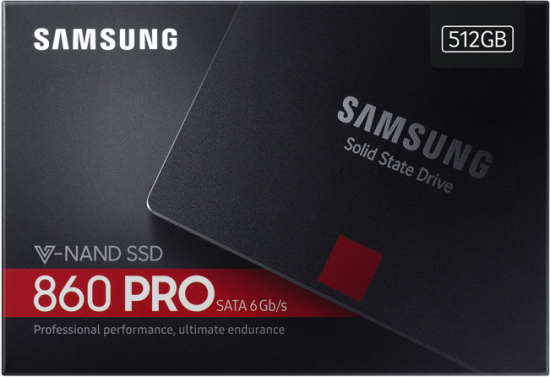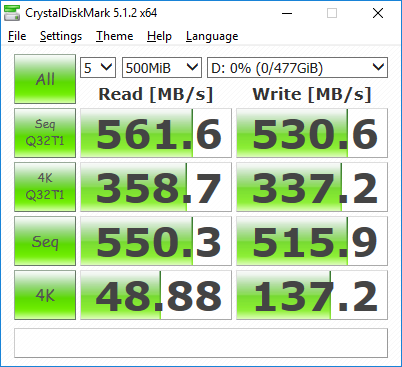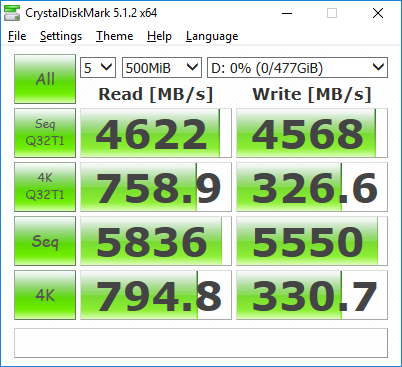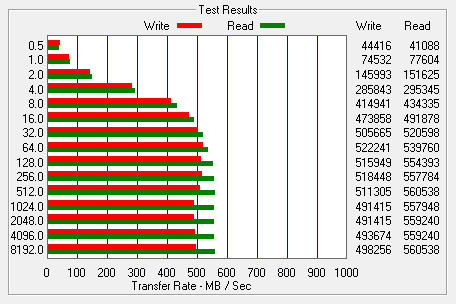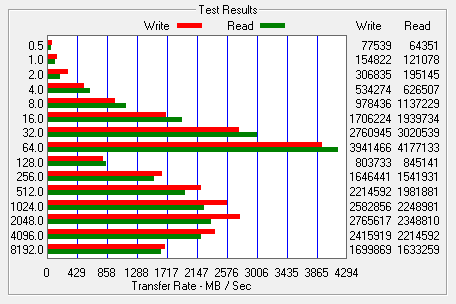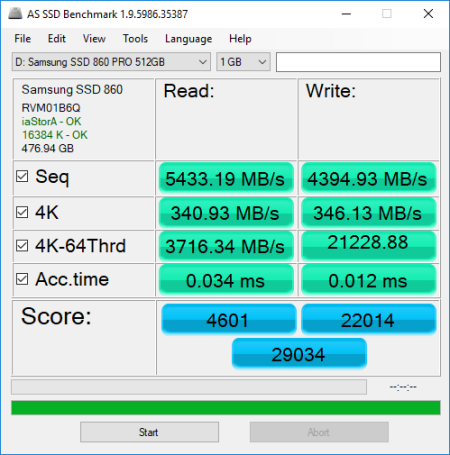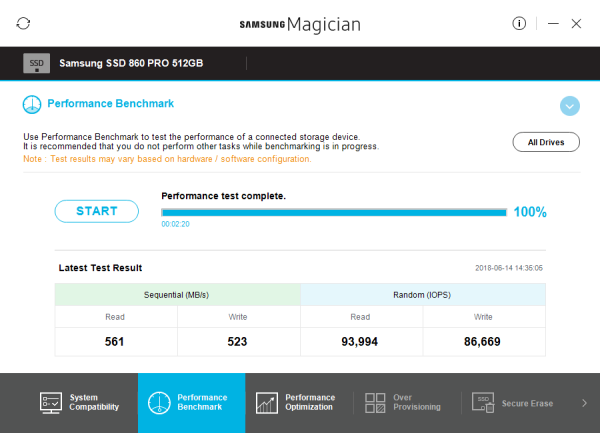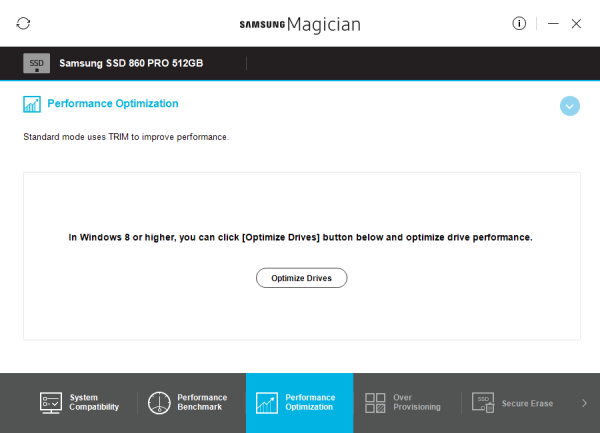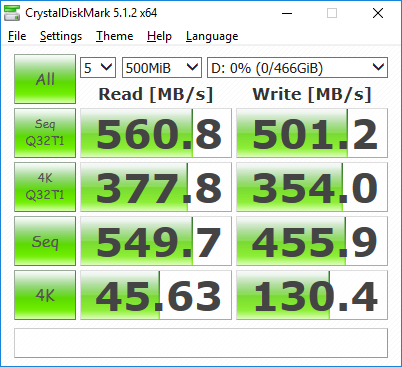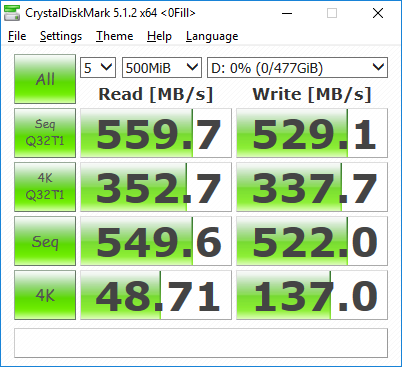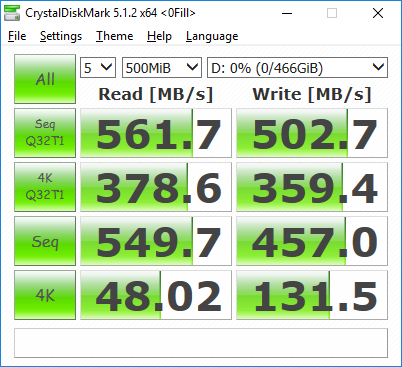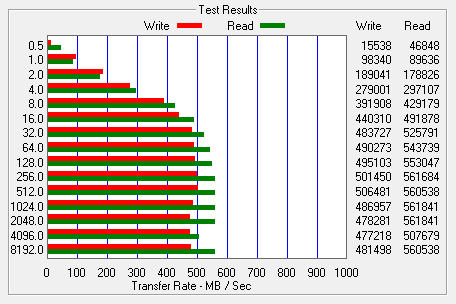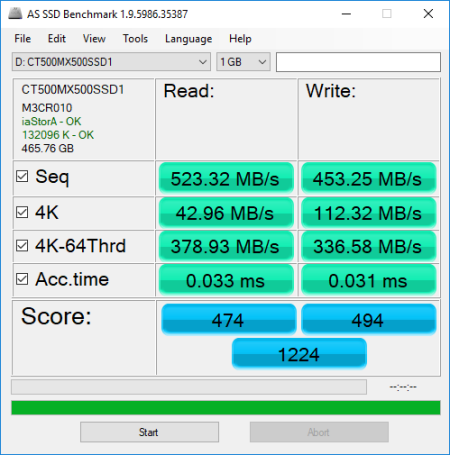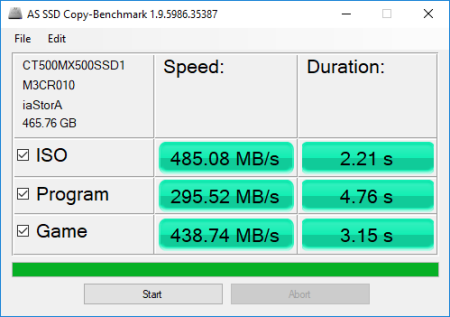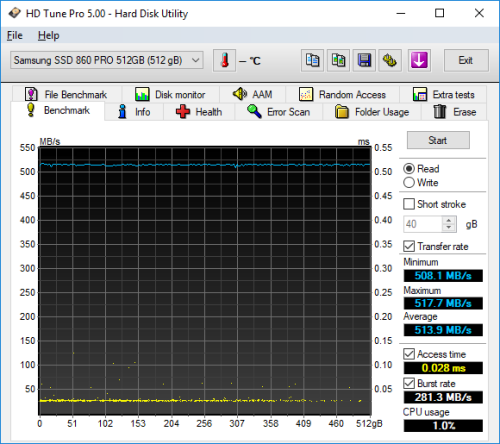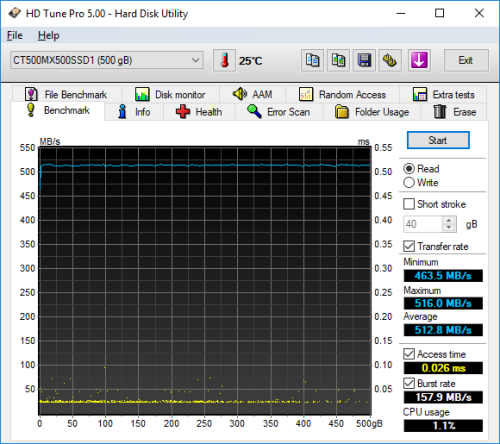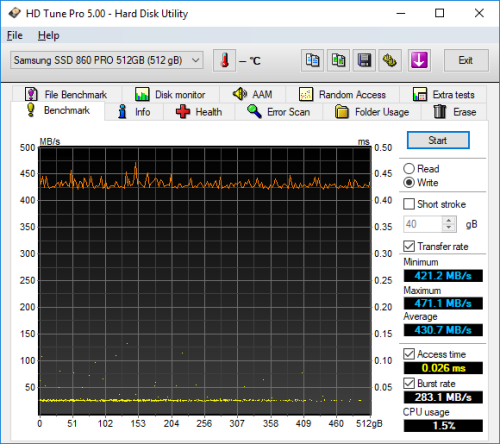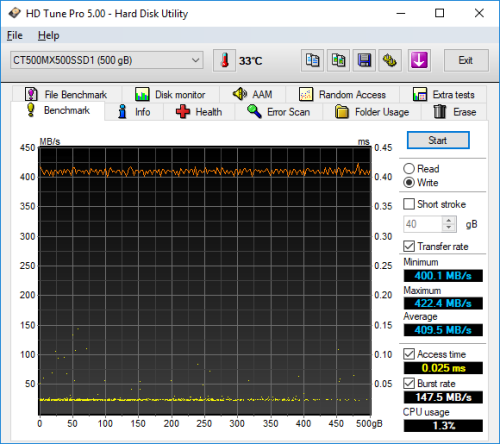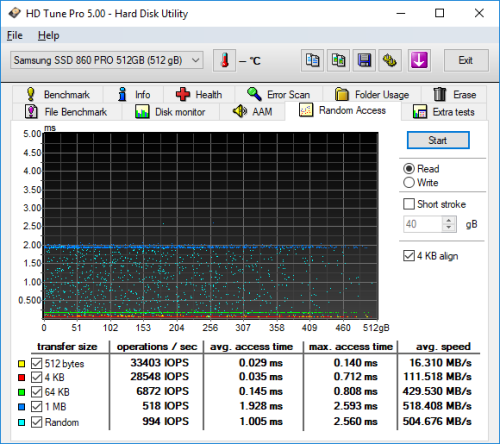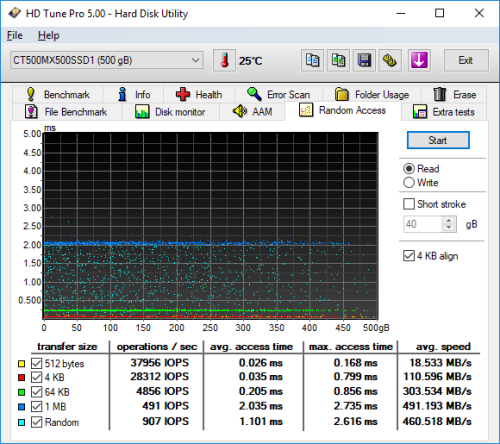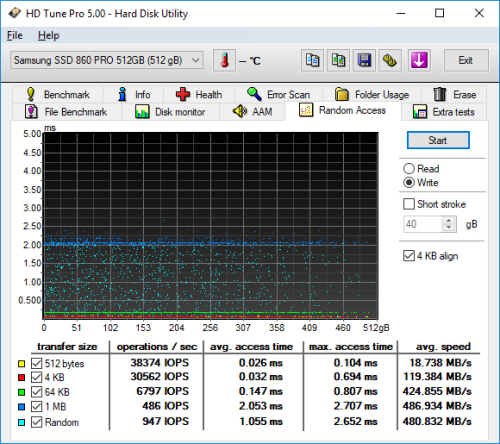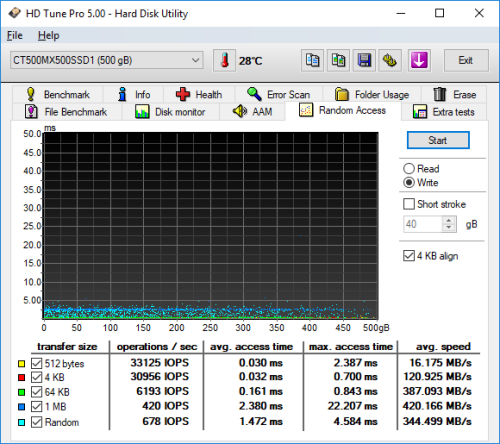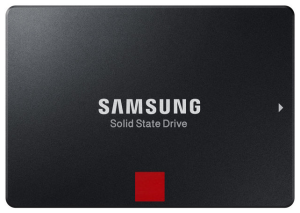
![]()
Model: Samsung 860 PRO 512GB Solid State Drive
Manufacturer: Samsung Electronics
Provided By: Samsung America
Samsung Electronics has been a leader in the electronics industry for more than 30 years. Since the introduction of their first television in 1970, this Korean company has grown to become one of the world's leading electronics manufacturers, offering everything from tiny semiconductors to large home appliances. Samsung is no stranger to the storage industry either. Along with an assortment of DVD and Blu-ray Disc drives, the company offers both hard drive and flash based storage solutions for the portable and desktop computer markets.
Earlier this year, Samsung introduced its 860 series SSDs. In addition to their new mainstream drive, the 860 EVO, the company released its latest high-performance SATA SSD, the 860 PRO. Designed to meet the needs of creators, professionals, and gamers, the 860 PRO is powered by Samsung's new MJX controller and is available with up to 4TB of their latest 2-bit MLC V-NAND flash. This combination not only delivers industry-leading performance, it gives the drive an endurance rating that is up to 8x higher than its predecessor, the 850 PRO. The 860 PRO also supports AES 256-bit hardware-based encryption and is compliant with TCG Opal and IEEE 1667. To top it all off, it comes with Samsung's Magician software and can be used with their RAPID technology. By using free PC memory as a cache, RAPID can push the performance of the SSD beyond the limits of the current SATA specification.
The 860 PRO is available in 256GB, 512GB, 1TB, 2TB and 4TB capacities. For this review, Samsung sent us the 512GB version of the drive, which is capable of delivering up to 560 MB/s sequential read and 530 MB/s sequential write speeds as well as up to 100,000 random read and 90,000 random write IOPS.
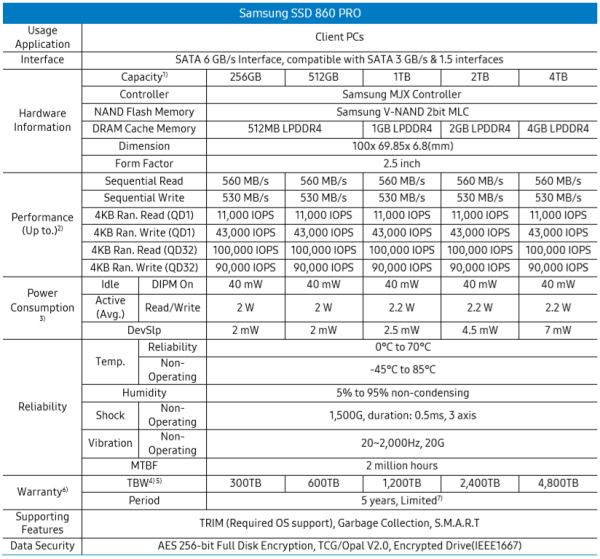
Needless to say, this is only a taste of what the 860 PRO has to offer. To give you an idea of what to expect, we'll take a closer look at Samsung's new SATA SSD and then see how well it performs. Does the 860 PRO have what it takes? Can it deliver the performance and features that we've come to expect from Samsung? Keep reading as we find out.
The 860 PRO comes in a small black and red box. While there aren't a lot of details on the front, the back of the box advertises some of the drive's key features including its V-NAND technology and 5 year warranty. Inside, you'll find the SSD as well as a small installation guide and warranty statement.
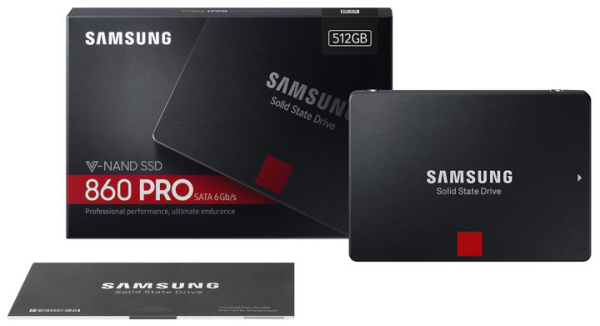
Physical Features:
Like Samsung's previous SSDs, the 860 PRO is very well constructed. The drive's outer casing is made entirely out of aluminum and is very strong and lightweight. The 860 PRO also shares the same black color scheme found on the 860 EVO. However, instead of a gray square, the one on the 860 PRO is red.
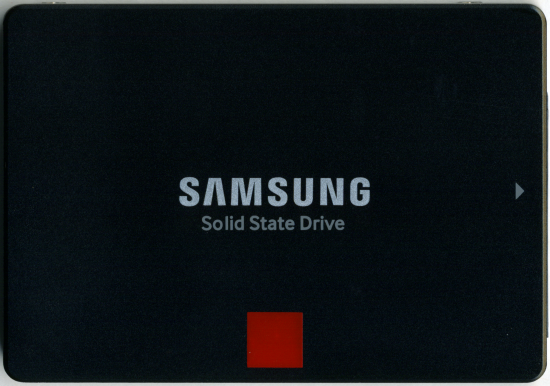

Upon opening the case, I was a bit surprised to see how small the 860 PRO's PCB was. Instead of a regular size PCB, Samsung has placed a half-slim SATA SSD inside of a 2.5" case.

Like the 860 EVO, the 860 PRO uses Samsung's new MJX controller. The company hasn't provided a lot of specifics regarding the controller's technical specs. However, they have stated that in addition it to providing faster communication with the host system, the MJX provides much wider compatibility with other devices. This includes improved queued trim which enhances Linux compatibility.


For the 512GB version of the 860 PRO, Samsung used their own 64-layer, 2-bit MLC V-NAND flash chips. Looking at the pictures above, you can see that there is a 256GB NAND flash package on either side of the PCB. The drive also has a single 512GB LPDDR4 DRAM memory chip that is used for caching.
The Samsung Magician software is designed to help users easily manage the health and performance of their Samsung SSD. From the main screen, users can check the condition of their drives and view information like the firmware, total capacity and the total bytes written. With the 860 PRO, the screen also shows whether or not AHCI is activated as well as the speed of the SATA interface its connected to.

From the main screen, users can also enable RAPID (Real-time Accelerated Processing of I/O Data) Mode. When enabled, RAPID mode is inserted as a filter driver in the Windows storage stack. The driver actively monitors all storage-related activity between and among the operating system, user applications and the SSD. The RAPID technology analyzes system traffic and leverages spare system resources (DRAM and CPU) to deliver read acceleration through intelligent caching of hot data and write optimization through tight coordination with the SSD.
Using Magician, users can check to see if there are any compatibility issues between their Samsung SSD and system. The software also provides information about a user's system including the OS, CPU, amount of memory and the model and BIOS version of the motherboard.

Samsung's Magician software can also be used to benchmark the performance of a storage device. Looking at the screenshot below, you can see that it tests the sequential and random read and write performance of a drive.
Magician also gives users the ability to improve the performance of their drive by forcing TRIM to run. In addition, users can optimize the performance and lifespan of their SSD by setting aside extra free space.
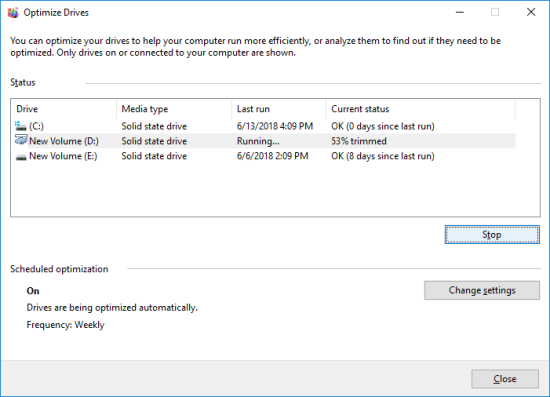
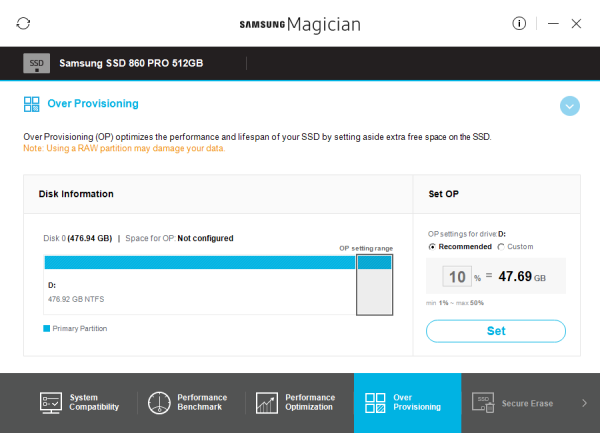
The Secure Erase feature provides the option to delete all data on an SSD in a way that it can never be recovered, restoring the drive to its original performance. Magician gives you the option to do this from within Windows. Otherwise, if your SSD is in a frozen state, you can create a bootable USB drive.
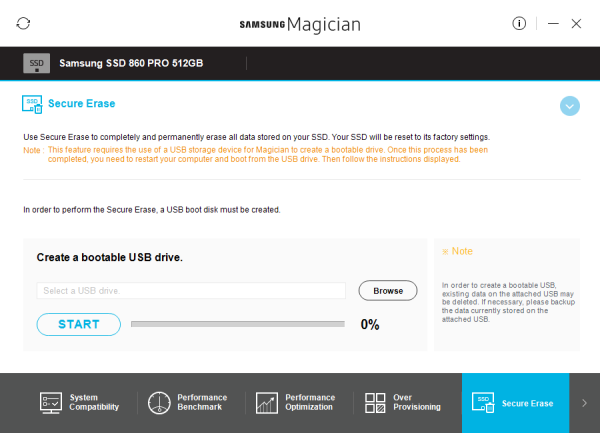
Last, but not least, you have the Data Security feature. From here, users can check to see which security settings have been enabled and read about these features.
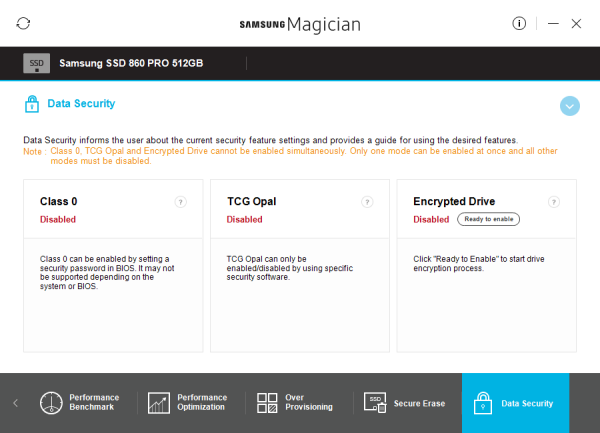
The test system used in this review is equipped with an Intel Core i7-6700K CPU, GIGABYTE GA-Z170X-UD3 motherboard, 32GB (16GB x 2) of Crucial Ballistix Sport LT DDR4 memory, Samsung 960 PRO 512GB SSD and a GIGABYTE GeForce GTX 1060 WINDFORCE OC 6G graphics card. For the operating system, I installed a fresh copy of Windows 10 Enterprise.
To test the performance of Samsung's 860 PRO SSD, I ran a series of benchmarks using CrystalDiskMark, HD Tach RW, ATTO Disk Benchmark, AS SSD, HD Tune Pro, Anvil's Storage Utilities, Iometer and PCMark 8. For comparison, I've also included test results from the Crucial MX500, Plextor M8V, Crucial BX300, ADATA Ultimate SU900, Plextor S3C, Toshiba OCZ VX500, ADATA Ultimate SU800, Plextor S2C, Crucial MX300, Plextor M7V, PNY CS1311, OCZ Trion 150, PNY CS2211, Plextor M6V, Crucial BX200, OCZ Trion 100, Kingston HyperX Savage, Crucial MX200, OCZ Vector 180, Kingston BX100, Samsung 850 EVO M.2, Samsung 850 EVO mSATA, AMD Radeon R7, Silicon Power Slim S80, Samsung SSD 850 EVO, OCZ ARC 100, SanDisk Ultra II, Crucial MX100, SanDisk Extreme Pro and Samsung SSD 850 PRO.
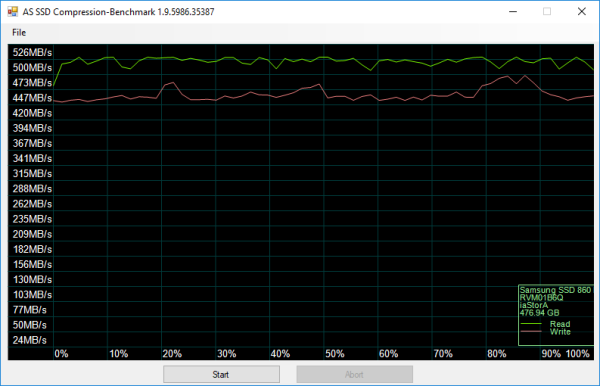
As I mentioned earlier, the 860 PRO uses Samsung's new MJX controller chip. Looking at the screenshot above, you can see that it performs equally well with both incompressible (0%) and compressible (100%) data.
CrystalDiskMark 5.1.2:
First, I ran a few quick tests using CrystalDiskMark. This benchmark tool measures the performance of a storage device by testing its sequential read and write speeds as well as its random read and write speeds using blocks 512K and 4K in size.
According to Samsung, the 512GB version of the 860 PRO is capable of reading at 560 MB/s and writing at 530 MB/s. Looking at the screenshot above, you can see that the drive had no problems reaching these speeds in CrystalDiskMark's sequential read and write tests.
The 860 PRO performed equally well when using highly compressible 0x00 (0 Fill) data. This time around, the drive was able to read at 559.7 MB/s and write at 529.1 MB/s.
HD Tach RW 3.0.4.0:
Next, I used HD Tach to test the 860 PRO's read, write and burst speeds as well as its seek times and CPU usage.
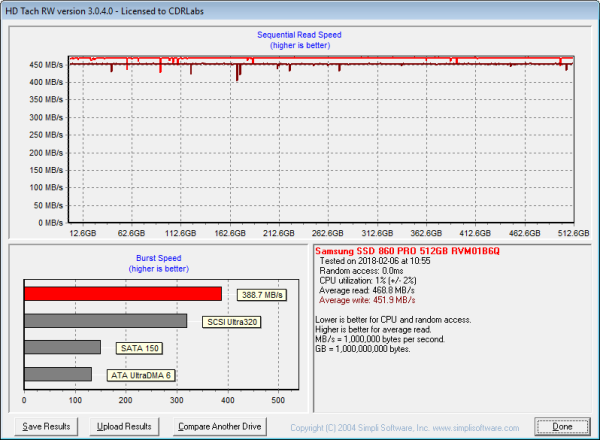
Looking at the screenshot above, you can see that the 860 PRO had average read and write speeds of 468.8 MB/s and 451.9 MB/s respectively, as well as a burst speed of 388.7 MB/s.
ATTO Disk Benchmark 2.46:
I also used ATTO Disk Benchmark to test the 860 PRO's sequential read and write speeds. The tests are run using blocks ranging in size from 0.5KB to 8192KB and the total length set to 256MB.
When tested with ATTO, the 860 PRO's read speeds topped out at about 560 MB/s and its write speeds at 522 MB/s.
AS SSD:
AS SSD is a benchmark designed specifically for solid state drives. The application contains five synthetic tests which are used to determine the sequential and random read and write performance of a drive.
AS SSD also includes a copy benchmark. This test copies an ISO (two large files), program (many small files) and game (small and large files), returning the speed and duration of each.
HD Tune Pro 5.00:
Next, I ran a series of tests using HD Tune Pro. This hard disk utility measures a drive's performance by testing its sequential read and write speeds as well as its access time, burst rate and CPU usage. For this review, I'm also going to use it to benchmark the 860 PRO's random read and write speeds, random access times and the number of operations per second.
The 860 PRO performed relatively well when benchmarked with HD Tune. The drive had average read and write speeds of 513.9 MB/s and 430.7 MB/s, respectively, and a burst rate of 281.3 MB/s when reading.
When reading 4KB blocks, the 860 PRO reached 28,548 IOPS and had an average speed of 111.518 MB/s. The drive was faster when writing, reaching 30,562 IOPS with an average speed of 119.384 MB/s.
Anvil's Storage Utilities:
Anvil's Storage Utilities is another new benchmark designed with SSDs in mind. The standard storage benchmark measures a drive's performance by testing its transfer speeds, access times and IOPS.
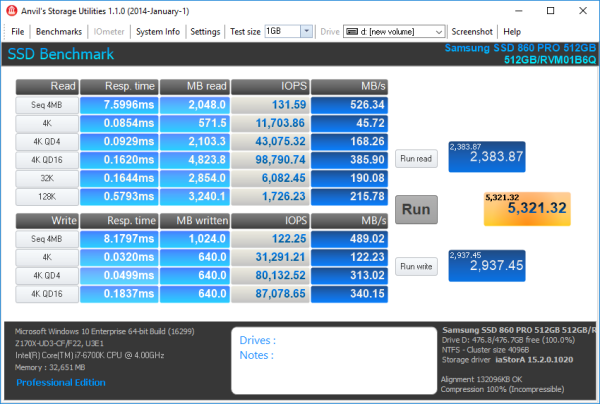
Iometer:
Lastly, I ran a series of tests using Iometer. This tool can be configured to benchmark a number of things. In this case, I used it to measure the MX500's read and write speeds and the number of operations per second. The tests were run using random bytes and a queue depth of 3.
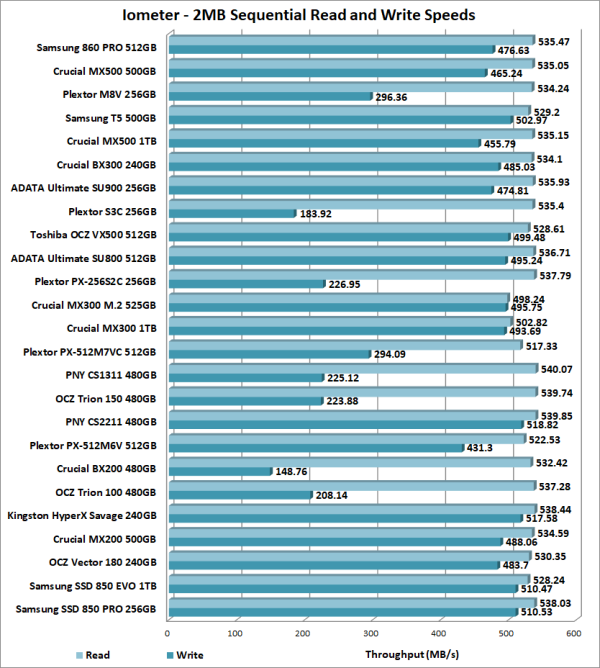
The 860 PRO's performance was very similar to what we saw in our other tests. The drive was able to read at 535.47 MB/s and write at 476.63 MB/s.

The 860 PRO also performed very well when doing random reads and writes. In our tests, the drive was able to read at 234.68 MB/s and write at an impressive 346.64 MB/s.

According to Samsung, the 512GB 860 PRO is capable of 100,000 IOPS when reading and 90,000 IOPS when writing 4K blocks. In our tests, the drive reached 60,078 random read IOPS and 88,740 random write IOPS. Increasing the queue depth had little impact on the 860 PRO's random write performance. However, with the queue depth set to 32, the drive was able to reach 98,388 random read IOPS.
Vantage PCMark 8 - Storage Test:
PCMark 8 is a complete benchmark for Windows. It includes five benchmark tests, each designed around a specific scenario. The storage benchmark measures drive performance using real-world traces recorded from Adobe Creative Suite, Microsoft Office and a selection of popular games.
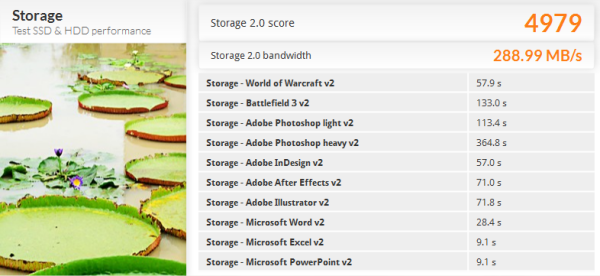
PCMark 8 also includes a consistency test which measures the performance consistency and degradation tendency of a storage system. The test reports the performance level at the start, the degraded steady-state, and the recovered state as well as the number of iterations required to reach them. For this test, we are focusing on the Adobe Photoshop (Heavy) trace and will look at both the bandwidth and latency of the drive
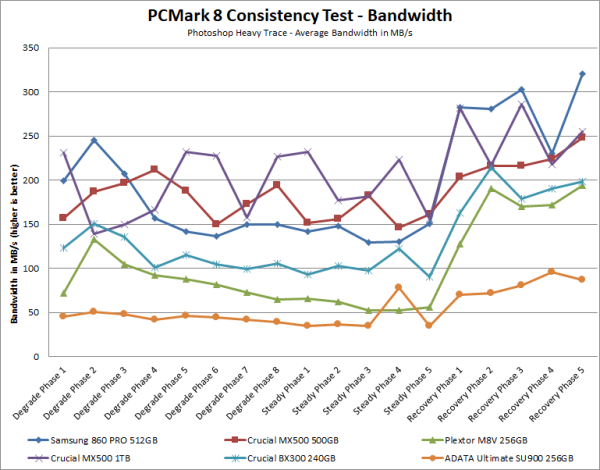
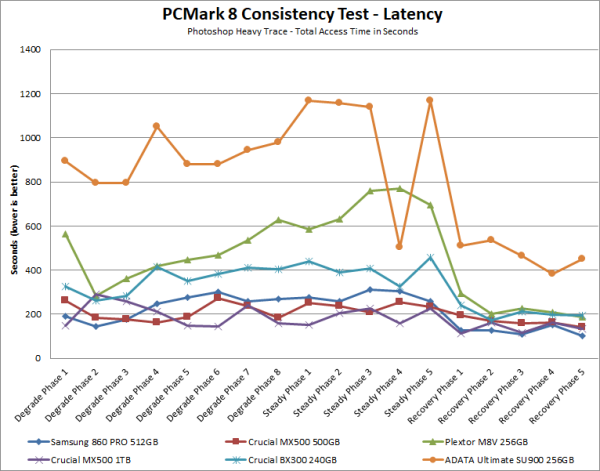
The 860 PRO did fairly well throughout PCMark's consistency test. While not as fast as the Crucial MX500, it performed better than the Plextor M8V and Crucial BX300 throughout the degradation and steady state phases. The 860 PRO's performance also increased during the recovery phase, topping out at about 320 MB/s.
TRIM Performance:
While SSDs offer many benefits, there are some downsides to using flash memory. One of the biggest issues people run into is performance degradation. Over time, an SSD will run out of fresh blocks and will have to write over data the file system has marked as deleted. This procedure is very complicated and can slow an SSD's write speeds considerably.
To fix this problem, most manufacturers have added TRIM support to their SSDs. The TRIM command allows an operating system, such as Windows 7, to tell an SSD which data blocks are no longer in use. Using this information, the drive pro-actively erases these blocks and adds them to the free block pool.

To test the 860 PRO's TRIM function, I first put the drive in a "dirty" state. I used Iometer to fill the entire drive and then ran a random write test for 30 minutes. This had little impact on the 860 PRO's read speed. However, its average writing speed dropped to a mere 57.1 MB/s.
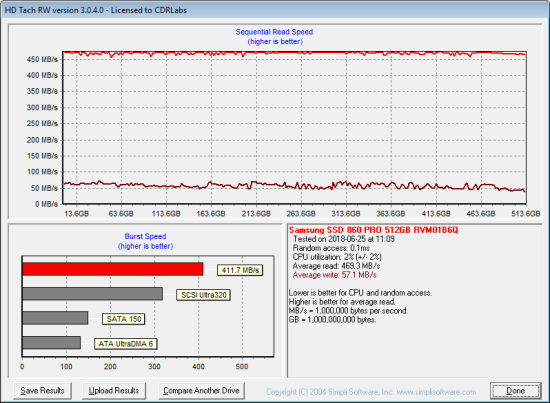
Samsung 860 PRO - Dirty
To see how well the 860 PRO could recover, I let the computer sit for about 30 minutes and then reran the test. The drive wasn't able to reach the factory fresh performance shown in our earlier tests. However, its average sequential write speed jumped up to 446.3 MB/s.

Samsung 860 PRO - After Trim
Lastly, I used Samsung's Magician software to perform a secure erase of the 860 PRO. With the drive wiped clean, it had average read and write speeds of 469.3 MB/s and 498.2 MB/s, respectively.

Samsung 860 PRO - Secure Erase
Final Thoughts:
With the 860 PRO, Samsung has raised the bar yet again, delivering one of, if not the best, consumer SATA SSDs on the market today. Designed for professionals and their high-end computing devices, the 860 PRO combines Samsung's new MJX controller with their latest 2-bit MLC V-NAND flash to deliver better performance and even more endurance than its already impressive predecessor, the 850 PRO. In our sequential read and write tests, the 512GB version of the 860 PRO was able to read at speeds as high as 561 MB/s and write at speeds in excess of 522 MB/s. It also did very well in our random write tests, producing more than 88,000 IOPS at low queue depths.
Impressive performance isn't the only thing the 860 PRO has to offer. To keep your data safe, the drive features AES 256-bit full disk encryption and is compliant with both the TCG Opal 2.0 and IEEE 1667 specifications. The 860 PRO also works with Samsung's Magician software and supports their RAPID technology, which uses spare system resources to boost the drive's read and write speeds. Last, but not least, the 860 PRO is covered by a 5 year warranty with an endurance rating of up to 4,800 terabytes written (TBW) for the 4TB model.
The 860 PRO is available now in 256GB, 512GB, 1TB, 2TB and 4TB capacities. capacities. Prices on Amazon.com currently range from $118 up to $1,700, with the 512GB version reviewed here going for about $210.

Highs:
- Equipped with 2-bit MLC V-NAND technology
- Available in 256GB, 512GB, 1TB, 2TB and 4TB capacities
- Good sequential and random read and write performance
- Large DRAM cache
- Supports TRIM, garbage collection and wear leveling
- Features RAPID mode
- AES 256-bit full disk encryption
- TCG Opal and IEEE 1667 compliant
- DEVSLP power mode
- Includes SSD Magician software and Data Migration Tool
- 5 year warranty
Lows:
- Pricey
